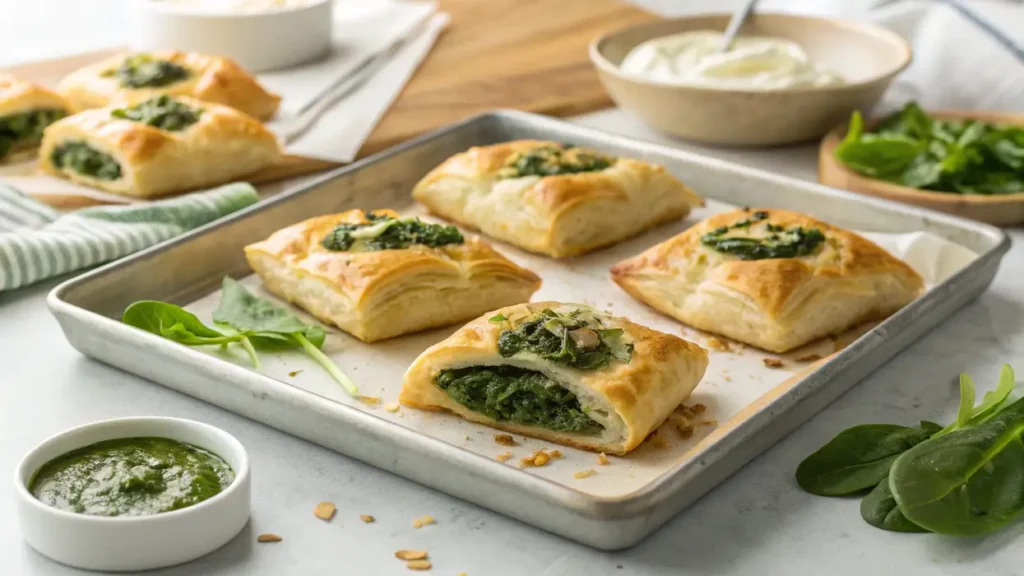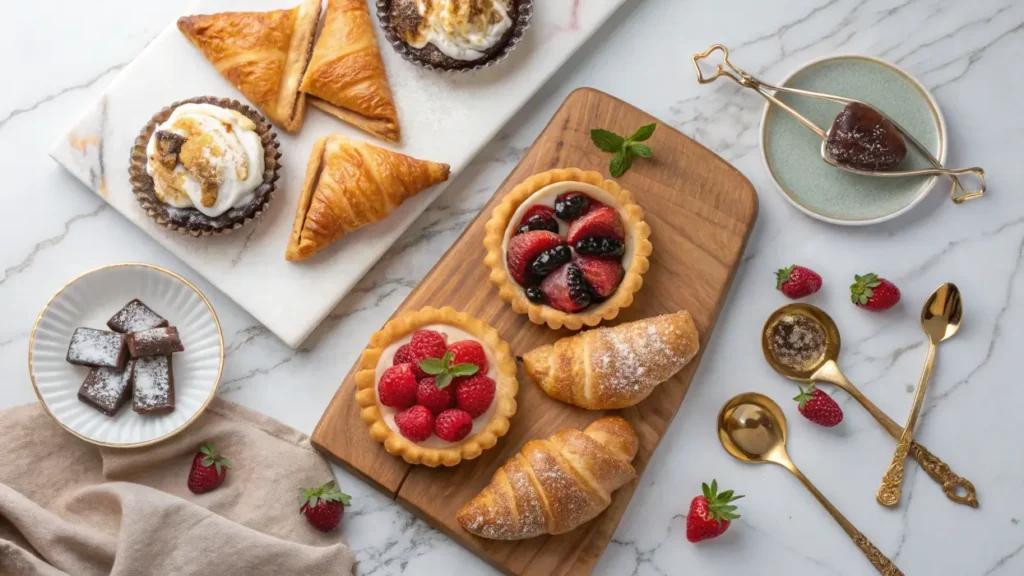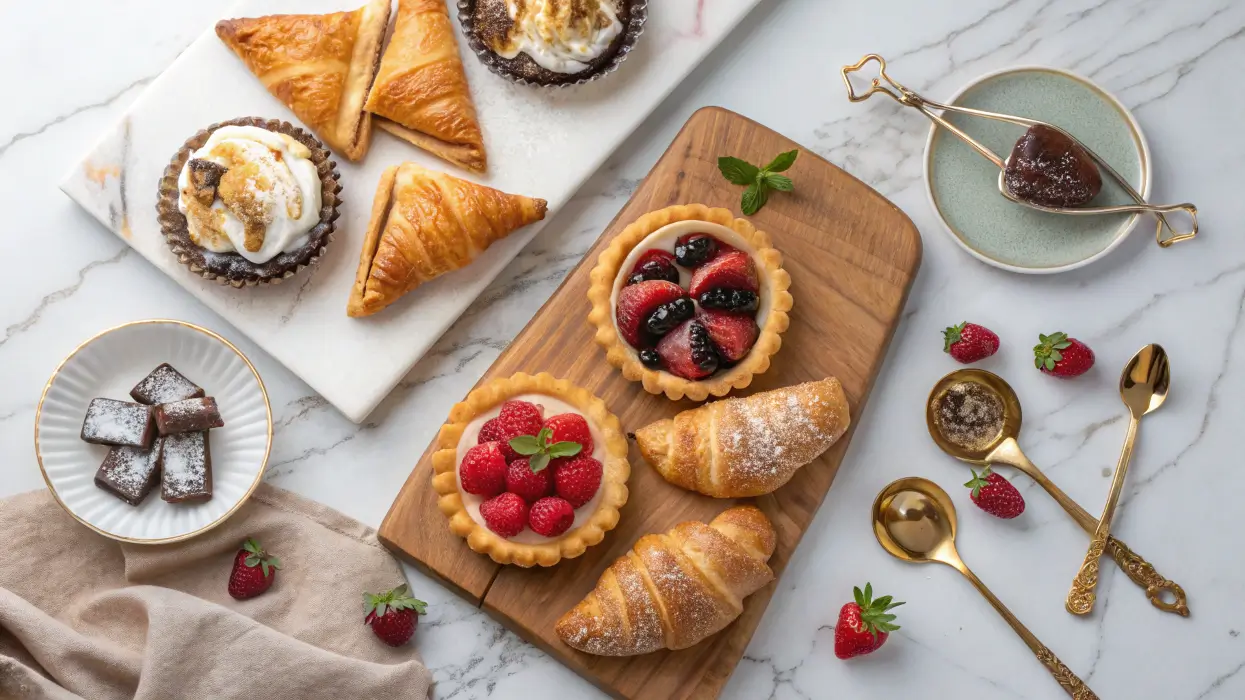Table of contents
- What is Puff Pastry with Filling Called?
- Introduction to Puff Pastry
- Historical Evolution of Filled Puff Pastries
- Popular Types of Filled Puff Pastries
- Key Techniques in Preparing Puff Pastry Fillings
- Culinary Applications and Fancy Names for Filled Pastries
- Common Types of Puff Pastry Dough
- FAQs About What is Puff Pastry with Filling Called?
- Conclusion and Final Thoughts
Estimated reading time: 9 minutes
What is Puff Pastry with Filling Called?
Puff pastry, with its light, flaky layers and rich buttery taste, has captivated food lovers for centuries. However, when it’s filled with delicious ingredients—be it sweet or savory—it takes on a new identity, celebrated in cuisines across the globe. As such, this article dives deep into what is puff pastry with filling called, exploring its types, techniques, and cultural significance.
From its beginnings in ancient kitchens to modern-day variations, we’ll uncover the secrets behind this culinary marvel. Whether you’re a foodie curious about its many names or an aspiring baker wanting to perfect your craft, this guide has something for you. So, let’s start with the basics.
Introduction to Puff Pastry
What is Puff Pastry?
Puff pastry is a type of laminated dough, created by folding layers of butter and dough to form a delicate, flaky texture. When baked, the butter melts, creating steam that puffs up the layers—hence the name. Laminated dough is the foundation for many renowned pastries, from croissants to mille-feuille.
The beauty of puff pastry lies in its versatility. It’s a blank canvas, lending itself to endless possibilities. Want something sweet? Add cream, chocolate, or fruit. Craving savory? Think cheese, meat, or vegetables wrapped in a buttery crust.
Importance of Puff Pastry in Culinary Arts
Puff pastry holds a revered spot in kitchens worldwide. Its ability to elevate dishes—from appetizers to desserts—is unmatched. For chefs and home cooks alike, it’s the go-to base for crafting impressive creations like vol-au-vents, pithiviers, and more.
Notably, puff pastry’s role isn’t just functional; it’s also deeply cultural. Across continents, people have adapted this dough to suit local tastes. Its endless adaptability is why it continues to shine in global gastronomy.
Historical Evolution of Filled Puff Pastries
Ancient Roots
Puff pastry’s journey started thousands of years ago with the Egyptians, who, through experimentation, layered dough and fat to create early versions of laminated dough. Although it wasn’t the puff pastry we know today, their innovation laid the groundwork for future culinary exploration. Similarly, in ancient Greece, the addition of honey and nuts to thin dough layers evolved into baklava, a dessert that remains beloved even today.
These innovations showcased the versatility of layering techniques, offering both savory and sweet variations. Consequently, this dual purpose made them popular across civilizations, blending cultural culinary traditions with local ingredients.
European Refinement
The refinement of puff pastry is credited to French chef Marie-Antoine Carême during the 19th century. Through his dedication, by perfecting the lamination technique, he elevated puff pastry to an art form, thereby making it a staple in haute cuisine. French bakers furthermore developed filled puff pastries, creating iconic dishes like vol-au-vents and pithiviers. As a result, this innovation spread rapidly, inspiring countless global adaptations.
Meanwhile, Italy and Spain embraced their versions, incorporating regional flavors like cream, fruit, and cheese into puff pastry dishes. The question, what is puff pastry with filling called, thus began to yield answers unique to each culture.
Modern Variations Around the World
Today, filled puff pastries come in myriad forms, from empanadas in Latin America to samosas in South Asia. Each version consequently reflects a cultural twist, proving the versatility of this dough. Whether it’s a savory Cornish pasty or a sweet mille-feuille, filled puff pastries have become a global favorite.
For a creative twist on pastry fillings, check out Cream Cheese Filling: Everything You Need to Know for inspiration.
Popular Types of Filled Puff Pastries

Savory Filled Pastries
Savory filled puff pastries often serve as appetizers or meals, packed with robust flavors. Examples include:
- Pithiviers: French pastries traditionally filled with meat or vegetables. Their domed shape makes them visually stunning.
- Empanadas: A Spanish and Latin American staple, featuring fillings like seasoned meats, cheese, or potatoes wrapped in flaky dough.
- Börek: Popular in the Balkans and Middle East, this pastry uses thin layers of filo and fillings like spinach, feta, or minced meat.
Sweet Filled Pastries
On the sweeter side, puff pastries have a universal appeal. Examples include:
- Mille-Feuille: Known as the “thousand-layer pastry,” it’s made with layers of puff pastry and cream. Its delicate texture pairs perfectly with fruit fillings.
- Cream Horn: A cone-shaped pastry filled with whipped cream or custard, often dusted with powdered sugar.
- Danish Pastry: A buttery delight topped with fruit preserves or cream cheese, perfect for breakfast or dessert.
Specialty Regional Variants
Around the world, puff pastry has been adapted to local palates:
- Pastizzi (Malta): A savory treat filled with ricotta or peas, showcasing the island’s unique culinary identity.
- Pineapple Cake (Taiwan): A sweet pastry filled with pineapple jam, blending traditional Taiwanese flavors with puff pastry techniques.
Each variation highlights the dough’s adaptability and cultural significance. No matter where you’re from, there’s likely a filled puff pastry that resonates with your taste buds.
Key Techniques in Preparing Puff Pastry Fillings
Classic Laminated Dough Preparation
Creating puff pastry begins with mastering laminated dough. This technique involves rolling butter into a base dough, folding it multiple times, and chilling it between folds. The layers of butter and dough create steam during baking, resulting in the flaky texture that defines puff pastry.
While this process may seem daunting, attention to detail is key. Keep the butter cold, roll the dough evenly, and rest it in the fridge to maintain the layers. These steps ensure the perfect foundation for what is puff pastry with filling called—a culinary masterpiece.
Tips for Achieving Perfect Fillings
The magic of filled puff pastries lies in the balance of flavors and textures. Here are some tips:
- Choose the Right Filling: Ensure the filling complements the buttery richness of the pastry. Sweet fillings like fruit compotes or custards pair well, while savory options like cheese or spinach add depth.
- Avoid Overfilling: Too much filling can lead to leakage during baking, ruining the presentation. Keep portions balanced for optimal results.
- Prevent Soggy Crusts: Use a light egg wash to seal the edges and create a barrier between the filling and the pastry.
For a deeper dive into pastry techniques, explore Cream Cheese Filling: Everything You Need to Know. It offers practical tips to elevate your pastry game.
Combining Techniques for Filled Pastries
The artistry of filled puff pastries lies in layering flavors and textures. Fold fruit fillings into dough for turnovers or pipe cream into hollow pastries post-baking. Experimenting with these techniques opens up a world of creative possibilities.
Culinary Applications and Fancy Names for Filled Pastries
What is Puff Pastry with Filling Called Across Cultures?
This question has many answers, as filled puff pastries have different names depending on their origin. For instance:
- In France, a filled puff pastry might be called a vol-au-vent or pithivier.
- In the Middle East, börek describes savory pastries with fillings like cheese or spinach.
- In Latin America, empanadas are beloved for their flaky crusts and flavorful fillings.
The term itself—what is puff pastry with filling called—reflects the global reach of this delicious dish.
Luxury in Pastries
Filled puff pastries often symbolize indulgence, thanks to their rich texture and intricate preparation. Desserts like mille-feuille or éclairs are staples of fine dining menus, celebrated for their delicate layers and exquisite flavors.
Beyond their taste, these pastries are a feast for the eyes. With latticed tops, golden crusts, and glossy finishes, they embody the art of baking.
A Recipe Suggestion
For more ideas, check out a recipe like Pastry with Frosting and Jelly Filling in Ring Shape. It’s an excellent way to explore the beauty of puff pastry.
Common Types of Puff Pastry Dough

The Three Main Types of Puff Pastry
Puff pastry may look complex, but it comes in three main types, each suited for specific uses:
- Regular Puff Pastry: This classic version involves multiple folds and layers of butter, producing the flaky texture we all love. It’s perfect for dishes where puffiness and crispness are key, like vol-au-vents or mille-feuille.
- Flaky Pastry: Known as “rough puff,” this quicker version uses larger chunks of butter, resulting in fewer layers but maintaining a delicious texture. It’s great for savory pies and tarts.
- Rough Puff Pastry: A simplified version, rough puff combines the buttery richness of traditional puff pastry with a shorter prep time. It works well for turnovers and rustic pastries.
Understanding these types helps bakers answer what is puff pastry with filling called in different contexts—whether it’s a high-end dessert or a comforting meat pie.
Use Cases for Each Type
- Sweet Dishes: Regular puff pastry’s even layers and airy texture are ideal for desserts like cream horns or palmiers.
- Savory Bakes: Flaky pastry pairs well with hearty fillings like chicken or vegetables, making it the go-to for pot pies.
- Quick Recipes: Rough puff pastry, with its fast preparation, is perfect for home cooks seeking a flaky crust without spending hours in the kitchen.
By knowing the right type of puff pastry for the job, you’ll elevate your baking and delight your guests.
FAQs About What is Puff Pastry with Filling Called?
A stuffed puff pastry can go by many names, depending on its filling and origin. For example, common terms include empanadas (Latin America), börek (Middle East), or vol-au-vent (France). As such, this versatility makes the question what is puff pastry with filling called both simple and endlessly intriguing.
The three types—regular puff, flaky pastry, and rough puff—each serve different culinary needs. For instance, regular puff pastry offers intricate layers, making it ideal for elegant dishes. Meanwhile, flaky pastry has a more rustic charm, perfect for hearty pies. Rough puff, on the other hand, is the time-saver that still delivers satisfying texture without compromising too much on quality.
In culinary circles, puff pastry is often referred to as pâte feuilletée in French. Moreover, when filled, it takes on names like mille-feuille or pithivier. These elegant terms, in turn, reflect the sophistication and artistry of puff pastry often showcased in high-end cooking.
A filled pastry encompasses a broad range of dishes, from savory to sweet. Terms like Danish, croissant, or turnover all describe specific styles. Globally, filled puff pastries hold unique names and cultural significance.
Conclusion and Final Thoughts
Puff pastry is a testament to the artistry of baking, and its filled variations therefore elevate it to an even higher culinary level. From vol-au-vents to empanadas, the answer to what is puff pastry with filling called depends on the cultural context and the creativity of the chef.
In addition, as we’ve explored, this versatile dough can transform into both sweet indulgences and savory delights. By understanding its history, preparation techniques, and global variations, you can thus unlock the potential of puff pastry in your own kitchen. Whether you’re perfecting classic recipes or experimenting with new ideas, puff pastry on the other hand offers endless possibilities.
For more inspiration and recipes, however, don’t forget to check out Pastry with Frosting and Jelly Filling in Ring Shape. Let your culinary adventures begin!

What Is Puff Pastry with Filling Called? Everything You Need to Know
Ingredients
For the Puff Pastry Dough:
- 2 1/2 cups all-purpose flour
- 1/4 teaspoon salt
- 1 cup unsalted butter chilled and cubed
- 1/2 cup ice-cold water
For Sweet Filling:
- 1 cup fruit compote or jam
- 1/2 cup custard or cream
For Savory Filling:
- 1 cup cooked spinach drained and chopped
- 1/2 cup feta or cream cheese
- Salt and pepper to taste
Instructions
Prepare the Dough:
- In a bowl, combine the flour and salt. Add the chilled, cubed butter and mix until the mixture resembles coarse crumbs.
- Slowly add ice-cold water, mixing just until the dough comes together. Wrap and refrigerate for 30 minutes.
Lamination Process:
- Roll out the dough into a rectangle on a floured surface. Fold it into thirds, like a letter. Rotate 90°, roll it out again, and fold. Repeat this process 4-6 times, chilling for 20 minutes between folds.
Add the Filling:
- Roll the dough to your desired thickness. Cut into shapes (rectangles or circles). Place your filling on one side, leaving a border.
- Fold the dough over the filling, press edges to seal, and crimp with a fork.
Bake:
- Preheat the oven to 400°F (200°C). Place filled pastries on a parchment-lined baking sheet.
- Brush with egg wash (1 egg beaten with 1 tablespoon water). Bake for 15-20 minutes or until golden brown.
Notes
- Keep the butter cold for the best results.
- Avoid overfilling to prevent leaks.
- Experiment with seasonal fruits or meats for unique flavors.
